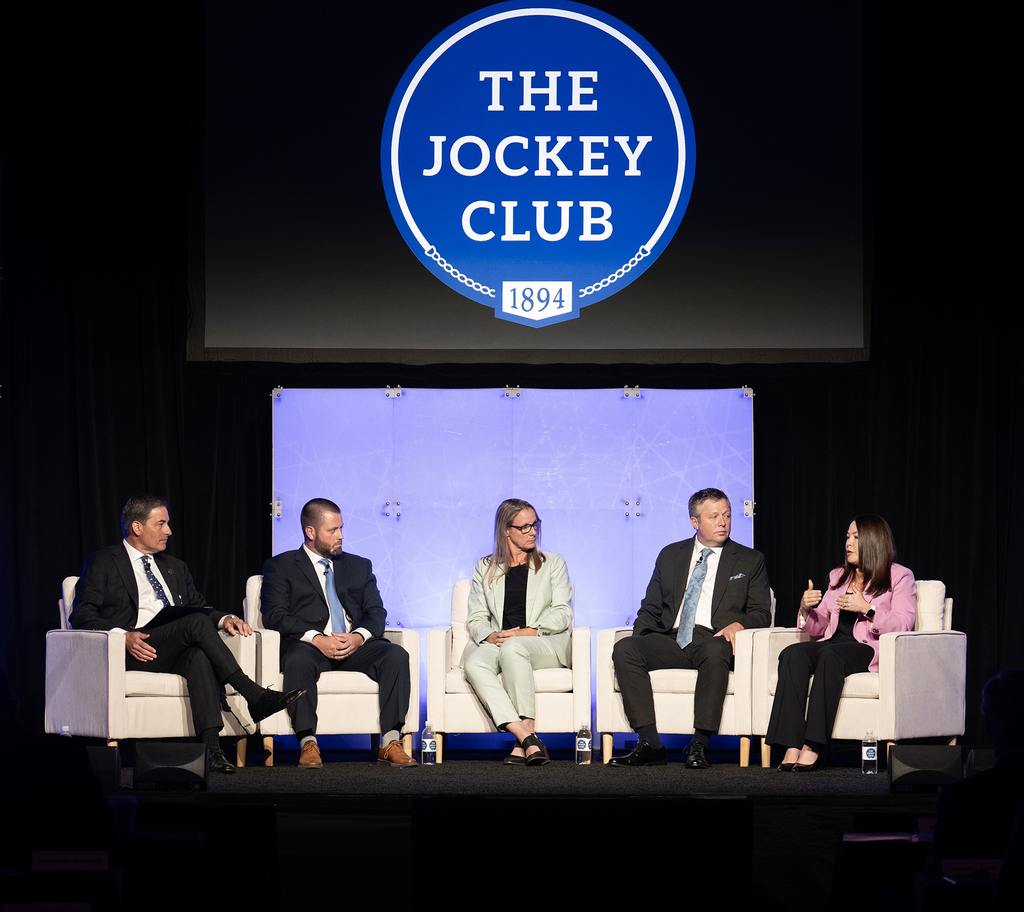
From left: James L. Gagliano, Ben Mosier, Jena Antonucci, Ron Moquett and Lisa Lazarus. (Jockey Club Photo)
Analytical Tools, Safety, and Global Reach Take Center Stage at The Jockey Club’s 71st Annual Round Table Conference
The Jockey Club Press Release
LEXINGTON, Ky.—In the keynote address of The Jockey Club’s 71st Annual Round Table Conference on Matters Pertaining to Racing, which concluded earlier today, Michael Lopez, senior director of Data and Analytics for the National Football League, discussed how analytical tools can help inform decision making, enhance safety, and improve the sport of horse racing.
“NFL football looks like it always has, but our stats and understanding of the game has never been better,” said Lopez. “This data revolution that came for baseball, basketball, soccer, and football will eventually come for horse racing soon. And that should excite you. Because the same questions you’ve always asked, you can get the answer to.
“One large data investment area for the league over the last decade has been in player health and safety,” Lopez continued. “Whatever horse racing’s priorities are – close races, safety of the horses and jockeys, time between races, and more – analytics can help address all of those, turning many decisions into an optimization problem.”
The conference was held at the Saratoga Springs City Center in Saratoga Springs, New York, and streamed on jockeyclub.com, The Jockey Club’s Facebook page, and through multiple industry outlets. Chairman Stuart S. Janney III presided over the conference.
In his closing remarks, Janney called for unity and collaboration among various organizations involved in the sport to ensure its sustainability and growth. Additionally, Janney suggested the industry must focus attention toward embracing the international aspect of the sport and enhancing marketing efforts to a new generation of fans.
“Racing is global, and thankfully in many parts of the world the sport is thriving,” said Janney. “One needs to look no further than the NFL, NBA, and MLB, which now regularly stage league games in Europe and Central America. To thrive, U.S. racing needs to embrace those international markets.”
Quoting former Round Table speaker, David Fuscus, Janney said, “If we come together as an industry, negative perception can be turned. There is hope we can come through these dark days, but to do so the public needs to understand what we are doing and believe we are on a path to success.”
Janney continued, “With HISA firmly established, we are on that path, and we need to aggressively begin to market to a new, younger audience, and defeat the extremist voices that threaten horse racing. Our best weapon is building a fan base who trusts the sport.”
Janney called for “all corners of the sport to come together to fund a sustained campaign that uses digital media to convey the attractiveness of our sport to a trusting new generation of fans,” and he noted that America’s Best Racing has a proven formula to make this happen.
Lindsay Czarniak, an Emmy-award winning sports reporter and anchor who works for FOX NFL and FOX NASCAR, presented observations regarding the marketing of horse racing. Using her extensive knowledge of sports coverage, Czarniak illuminated opportunities to enhance the reach of the sport.
“I’ve covered an array of sports, but nowadays consuming things has become so much more personal. What makes them feel good, uplifted, hopeful. You have to give the people what they want before they know they want it,” Czarniak said.
“A key part of sports marketing is relatability, and storytelling is key. Fans want authenticity, and there’s very little patience for anything that doesn’t seem real,” she continued. “This sport has the ability to offer those stories unlike any other with horses like Flightline or Cody’s Wish. Once they’re invested, keep them there.”
Pat Cummings, executive director of the Thoroughbred Idea Foundation, hosted a panel focused on computer-assisted wagering and its effects on racetracks and bettors. Panelists included Marshall Gramm, a professor at Rhodes College in Memphis, Tennessee, and co-founder of the Ten Strike Racing syndicate, and Joe Longo, the general manager of NYRA Content Management Solutions.
“Computer-assisted wagering gets a bad rap, but it’s the evolution of the betting product. There’s no stepping back from computers, and our future horseplayer is very tech-savvy,” said Gramm. “The competition we face is fierce, so we need to help steer newcomers.”
“On-track incentives can help the track, the horseman, and new players to learn more about our sport and get more competitive about wagering. More winning prices equals more winning days, and some of the greatest defenders of the sport are horseplayers. We need more fans, and those fans can be drawn to us through the betting window,” said Gramm.
“We have to make sure the Thoroughbred industry thrives, and a major part of that is the player,” added Longo.
James L. Gagliano, president and chief operating officer of The Jockey Club, interviewed panelists Lisa Lazarus, CEO of Horseracing Integrity and Safety Authority (HISA); Ben Mosier, executive director of the Horseracing Integrity & Welfare Unit; and trainers Jena Antonucci and Ron Moquett about their experiences with the HISA a year into enactment.
Discussing challenges of HISA implementation, Moquett said, “You’re dealing with a large group of people who are getting introduced to technology for the first time. As trainers, we’re constantly in our own realm. You need to come into the barn and talk to them since they’re not on Twitter or checking every email that comes in.”
“With every possible complaint there is, talk with us to find a solution to what your concern is, and then we can evolve productively,” said Antonucci.
Mosier added that these challenges and resistance to change is not limited to the sport of horse racing. “The same things we are talking about now are prevalent in all other sports at the highest level,” Mosier said.
“The philosophy of the program is that we want to protect the 99% of trainers who compete fairly against the small fraction that don’t,” said Lazarus “Our only goal is to do right by the majority of the industry. The intention truly isn’t to catch small mistakes of things that can’t be controlled.”
Reflecting on the benefits of HISA so far, Antonucci concluded, “A year in, the greatest impact of HISA is that me and my horses now have the opportunity to compete down the homestretch eye to eye, and there’s not a pharmaceutical in our way.”
Kyle McDoniel, president and chief operating officer of Equibase, presented insights on E-GPS and opportunities for Equibase to help grow the sport.
Kristin Werner, senior counsel for The Jockey Club, discussed improved traceability of Thoroughbreds and analysis of the Equine Injury Database, which shows that 99.88% of Thoroughbred races were completed without a fatality last year. She also announced a recommendation of the Thoroughbred Safety Committee regarding making track surface data available to everyone, which can be found on The Jockey Club website,jockeyclub.com.
A video replay of the Round Table Conference will be available on The Jockey Club website Friday, August 4, and an official transcript of the proceedings will be available next week.



